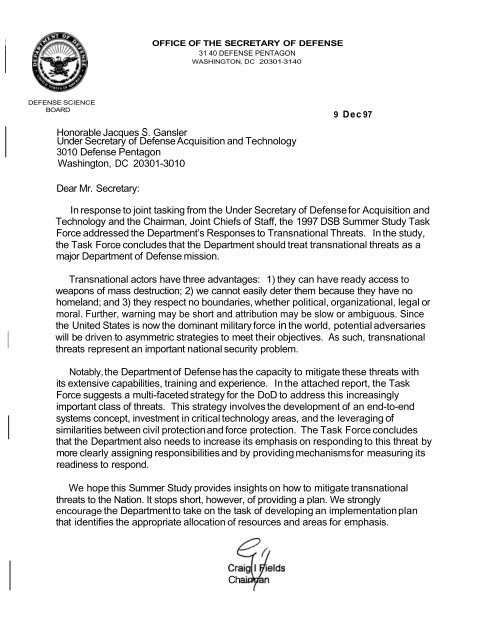DoD Responses to Transnational Threats - The Black Vault
DoD Responses to Transnational Threats - The Black Vault
DoD Responses to Transnational Threats - The Black Vault
Create successful ePaper yourself
Turn your PDF publications into a flip-book with our unique Google optimized e-Paper software.
OFFICE OF THE SECRETARY OF DEFENSE<br />
31 40 DEFENSE PENTAGON<br />
WASHINGTON, DC 20301-3140<br />
DEFENSE SCIENCE<br />
BOARD<br />
Honorable Jacques S. Gansler<br />
Under Secretary of Defense Acquisition and Technology<br />
3010 Defense Pentagon<br />
Washing<strong>to</strong>n, DC 20301 -3010<br />
9 Dec97<br />
Dear Mr. Secretary:<br />
In response <strong>to</strong> joint tasking from the Under Secretary of Defense for Acquisition and<br />
Technology and the Chairman, Joint Chiefs of Staff, the 1997 DSB Summer Study Task<br />
Force addressed the Department’s <strong>Responses</strong> <strong>to</strong> <strong>Transnational</strong> <strong>Threats</strong>. In the study,<br />
the Task Force concludes that the Department should treat transnational threats as a<br />
major Department of Defense mission.<br />
I<br />
<strong>Transnational</strong> ac<strong>to</strong>rs have three advantages: 1) they can have ready access <strong>to</strong><br />
weapons of mass destruction; 2) we cannot easily deter them because they have no<br />
homeland; and 3) they respect no boundaries, whether political, organizational, legal or<br />
moral. Further, warning may be short and attribution may be slow or ambiguous. Since<br />
the United States is now the dominant military force in the world, potential adversaries<br />
will be driven <strong>to</strong> asymmetric strategies <strong>to</strong> meet their objectives. As such, transnational<br />
threats represent an important national security problem.<br />
Notably, the Department of Defense has the capacity <strong>to</strong> mitigate these threats with<br />
its extensive capabilities, training and experience. In the attached report, the Task<br />
Force suggests a multi-faceted strategy for the <strong>DoD</strong> <strong>to</strong> address this increasingly<br />
important class of threats. This strategy involves the development of an end-<strong>to</strong>-end<br />
systems concept, investment in critical technology areas, and the leveraging of<br />
similarities between civil protection and force protection. <strong>The</strong> Task Force concludes<br />
that the Department also needs <strong>to</strong> increase its emphasis on responding <strong>to</strong> this threat by<br />
more clearly assigning responsibilities and by providing mechanisms for measuring its<br />
readiness <strong>to</strong> respond.<br />
We hope this Summer Study provides insights on how <strong>to</strong> mitigate transnational<br />
threats <strong>to</strong> the Nation. It s<strong>to</strong>ps short, however, of providing a plan. We strongly<br />
encourage the Department <strong>to</strong> take on the task of developing an implementation plan<br />
that identifies the appropriate allocation of resources and areas for emphasis.<br />
Ch





![Combat Support in Korea [270 Pages] - The Black Vault](https://img.yumpu.com/49796461/1/190x71/combat-support-in-korea-270-pages-the-black-vault.jpg?quality=85)











